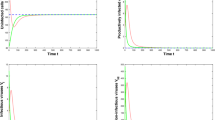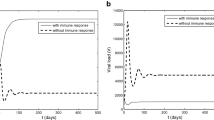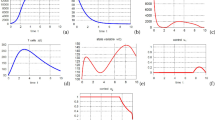Abstract
Human immunodeficiency virus infection destroys immune system of an HIV infected individual, which results in the risk of other life threatening diseases such as kidney disease, liver disease, diabetes and some types of cancer. To date, there is no cure of this infectious disease, however, there exist antiretroviral drugs which help an HIV infected individual to live a quality life. But, these antiretroviral drugs are costly and have different side effects. Recent studies indicate that immunotherapy can be used in addition to these antiretroviral drugs for better management of HIV infection. In this study, we consider an HIV infection model incorporating the effects of antiretroviral drugs and immunotherapy. We verify that the model solutions are non-negative and bounded in the feasible domain. Stability analysis of HIV infection-free equilibrium point indicates that HIV is eradicated for a basic reproduction number less than one. In order to maximize healthy CD4\(^+\) T cells with minimum cost and side effects of drugs, we propose an optimal control problem with two different objectives. The optimal control problems are solved using discretization and large-scale optimization methods. We obtain optimal treatment strategies for antiretroviral drugs and immune boosting drugs.










Similar content being viewed by others
References
Ahr, B., Robert-Hebmann, V., Devaux, C., Biard-Piechaczyk, M.: Apoptosis of uninfected cells induced by HIV envelope glycoproteins. Retrovirology (2004). https://doi.org/10.1186/1742-4690-1-12
Betts, J.T.: Practical Methods for Optimal Control and Estimation Using Nonlinear Programming, Advances in Control and Design, vol. 19. Society for Industrial and Applied Mathematics, Philadelphia (2010)
Ciupe, M.S., Bivort, B.L., Bortz, D.M., Nelson, P.W.: Estimating kinetic parameters from HIV primary infection data through the eyes of three different mathematical models. Math. Biosci. 200, 1–27 (2006)
Coddington, E.A., Levinson, N.: Theory of Ordinary Differential Equations. Tata McGraw-Hill Education, New York (1955)
Danane, J., Meskaf, A., Allali, K.: Optimal control of a delayed hepatitis B viral infection model with HBV DNA-containing capsids and CTL immune response. Optim. Control Appl. Meth. 39, 1–11 (2018)
Denizot, M., Varbanov, M., Espert, L., Robert-Hebmann, V., Sagnier, S., Garcia, E., Curriu, M., Mamoun, R., Blanco, J., Biard-Piechaczyk, M.: HIV-1 gp41 fusogenic function triggers autophagy in uninfected cells. Autophagy 4(8), 998–1008 (2008)
Douek, D.C., Brenchley, J.M., Betts, M.R., Ambrozak, D.R., Hill, B.J., Okamoto, Y., Casazza, J.P., Kuruppu, J., Kunstman, K., Wolinsky, S., et al.: HIV preferentially infects HIV-specific CD4+ T cells. Nature 417, 95–98 (2002)
Driessche, P.V., Watmough, J.: Reproduction numbers and sub-threshold endemic equilibra for compartmental models of disease transmission. Math. Biosci. 180(1–2), 29–48 (2002)
Embretson, J., Zupancic, M., Ribas, J.L., Burke, A., Racz, P., Racz, K.T., Haase, A.T.: Massive covert infection of helper T lymphocytes and macrophages by HIV during the incubation period of AIDS. Nature 362, 359–362 (1993)
Fleming, W.H., Rishel, R.W.: Deterministic and Stochastic Optimal Control. Springer, New York (1975)
Fourer, R., Gay, D.M., Kernighan, B.W.: AMPL: A Modeling Language for Mathematical Programming. Duxbury Press, Brooks-Cole Publishing Company, Monterey (1993)
Frydas, A., Leptokaridou, E., Partsanakis, E., Kourklidou, M., Sarantopoulos, A.: Emerging therapies in HIV infection: is the immune response the answer? J. Autoimmune Disord. 4(3), 56 (2018)
Garg, H., Mohl, J., Joshi, A.: HIV-1 induced bystander apoptosis. Viruses 4, 3020–3043 (2012)
Geng, Y., Xu, J.: Stability and bifurcation analysis for a delayed viral infection model with full logistic proliferation. Int. J. Biomath. 13(05), 2050033 (2020). https://doi.org/10.1142/S1793524520500333
Göllmann, L., Maurer, H.: Theory and applications of optimal control problems with multiple time-delays. J. Ind. Manag. Optim. 10, 413–441 (2016)
Gougeon, M.L., Colizzi, V., Dalgleish, A., Montagnier, L.: New concepts in AIDS pathogenesis. AIDS Res. Hum. Retrovir. 9, 287–289 (1993)
Grossman, Z., Meier-Schellersheim, M., Sousa, A.E., Victorino, R.M., Paul, W.E.: CD4+ T cell depletion in HIV infection: are we closer to understanding the cause? Nat. Med. 8, 319–323 (2002)
Gumel, A.B., Shivakumar, P.N., Sahai, B.M.: A mathematical model for the dynamics of HIV-1 during the typical course of infection. Nonlinear Anal. Theory Methods Appl. 47(3), 1773–1783 (2001)
Gupta, P.K., Dutta, A.: A mathematical model on HIV/AIDS with fusion effect: analysis and homotopy solution. Eur. Phys. J. Plus 134, 265 (2019). https://doi.org/10.1140/epjp/i2019-12599-8
Gupta, P.K., Dutta, A.: Numerical Solution with analysis of HIV/AIDS Dynamics model with effect of fusion and cure rate. Numer. Algebra Control Optim. 9(4), 393–399 (2019)
Hager, W.W.: Runge–Kutta methods in optimal control and the transformed adjoint system. Numer. Math. 87, 247–282 (2000)
Hattaf, K., Yousfi, N.: Two optimal treatments of HIV infection model. World J. Model. Simul. 8(1), 27–35 (2012)
Hattaf, K., Rachik, M., Saadi, S., Yousfi, N.: Optimal control of treatment in a basic virus infection model. Appl. Math. Sci. 3(20), 949–958 (2009)
Kariuki, S.M., Musyoki, S.K., Kemoi, E.K.: Immunotherapeutic treatment of HIV-1: review of safety and efficacy. Int. J. Cur. Res. Rev. 7(24), 24–29 (2015)
LaSalle, J.P.: The stability of dynamical systems. In: Regional Conference Series in Applied Mathematics. SIAM, Philadelaphia (1976)
Lee, E.B., Markus, L.: Foundations of Optimal Control. John Wilea Inc, New York (1967)
Lukes, D.L.: Differential Equations: Classical to Controlled, Mathematics in Science and Engineering, p. 162. Academic Press, New York, NY (1982)
McCune, J.M.: The dynamics of CD4+ T-cell depletion in HIV disease. Nature 410, 974–979 (2001)
Ogunlaran, O.M., Noutchie, S.C.O.: Mathematical model for an effective management of HIV infection. BioMed Res. Int. 2016, 4217548 (2016). https://doi.org/10.1155/2016/4217548
Pawelek, K.A., Liu, S., Pahlevani, F., Rong, L.: A model of HIV-1 infection with two time delays: mathematical analysis and comparison with patient data. Math. Biosci. 235, 98–109 (2012)
Poonia, B.: Immunotherapy in HIV infection. J. Infect. Dis. Ther. (2013). https://doi.org/10.4172/2332-0877.1000102
Pontryagin, L., Boltyanskii, V., et al.: The Mathematical Theory of Optimal Processes. Wiley, New York (1962)
Shamsara, E., Afsharnezhad, Z., Effati, S.: Optimal drug control in a four-dimensional HIV infection model. Optim. Control Appl. Methods (2019). https://doi.org/10.1002/oca.2555
Silva, C.J., Maurer, H.: Optimal control of HIV treatment and immunotherapy combination with state and control delays. Optim. Control Appl. Methods (2019). https://doi.org/10.1002/oca.2558
Srivastava, P.K., Chandra, P.: Modeling the dynamics of HIV and CD4+ T cells during primary infection. Nonlinear Anal. Real World Appl. 11(2), 612–618 (2010)
Vanham, G., Van Gulck, E.: Can immunotherapy be useful as a “functional cure” for infection with human immunodeficiency virus-1? Retrovirology 9(1), 1–21 (2012). https://doi.org/10.1186/1742-4690-9-72
Wächter, A., Biegler, L.T.: On the implementation of an interior-point filter line-search algorithm for large-scale nonlinear programming. Math. Program. 106, 25–57 (2006)
World Health Organization. https://www.who.int/news-room/fact-sheets/detail/hiv-aids. Accessed 20 July 2021
World Health Organization: Interim WHO Clinical Staging of HIV/AIDS and HIV/AIDS Case Definitions for Surveillance: African Region (2005). http://www.who.int/hiv/pub/guidelines/clinicalstaging.pdf. Accessed 20 July 2021
Willems, J.L.: Stability Theory of Dynamical Systems. Wiley, New York (1970)
Acknowledgements
The authors of this paper are grateful to the reviewers on the basis of whose reports and suggestions the improvements of the paper was possible. Also, the authors thank the editor of the journal for his supports during the communication of the paper.
Author information
Authors and Affiliations
Contributions
All authors jointly worked on the results and they read and approved the final manuscript.
Ethics declarations
Availability of Data and Materials
Not applicable.
Conflict of interests
Authors declare that there is no competing interests.
Funding
There is no funding for this work.
Additional information
Publisher's Note
Springer Nature remains neutral with regard to jurisdictional claims in published maps and institutional affiliations.
Rights and permissions
About this article
Cite this article
Nath, B.J., Sarmah, H.K. & Maurer, H. An Optimal Control Strategy for Antiretroviral Treatment of HIV Infection in Presence of Immunotherapy. Qual. Theory Dyn. Syst. 21, 30 (2022). https://doi.org/10.1007/s12346-022-00564-3
Received:
Accepted:
Published:
DOI: https://doi.org/10.1007/s12346-022-00564-3




